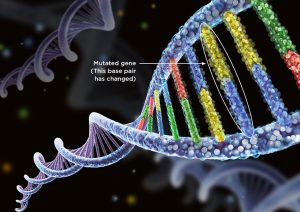The Relationship Between Mutations And Polymorphisms – Zoology Notes – For W.B.C.S. Examination.
While a mutation is defined as any alteration in the DNA sequence, biologists use the term “single nucleotide polymorphism” (SNP) to refer to a single base pair alteration that is common in the population. Specifically, a polymorphism is any genetic location at which at least two different sequences are found, with each sequence present in at least 1% of the population.Continue Reading The Relationship Between Mutations And Polymorphisms – Zoology Notes – For W.B.C.S. Examination.
Note that the term “polymorphism” is generally used to refer to a normal variation, or one that does not directly cause disease. Moreover, the cutoff of at least 1% prevalence for a variation to be classified as a polymorphism is somewhat arbitrary; if the frequency is lower than this, the allele is typically regarded as a mutation (Twyman, 2003).
SNPs are important as markers, or signposts, for scientists to use when they look at populations of organisms in an attempt to find genetic changes that predispose individuals to certain traits, including disease. On average, SNPs are found every 1,000–2,000 nucleotides in the human genome, and scientists participating in the International HapMap Consortium have mapped millions of these alterations (International Human Genome Sequencing Consortium, 2001).
Types of Changes in DNA
The DNA in any cell can be altered through environmental exposure to certain chemicals, ultraviolet radiation, other genetic insults, or even errors that occur during the process of replication. If a mutation occurs in a germ-line cell (one that will give rise to gametes, i.e., egg or sperm cells), then this mutation can be passed to an organism‘s offspring. This means that every cell in the developing embryo will carry the mutation. As opposed to germ-line mutations, somatic mutations occur in cells found elsewhere in an organism’s body. Such mutations are passed to daughter cells during the process of mitosis , but they are not passed to offspring conceived via sexual reproduction.
As mentioned, sickle-cell anemia is the result of a change in a single nucleotide, and it represents just one class of mutations called point mutations. Changes in the DNA sequence can also occur at the level of the chromosome, in which large segments of chromosomes are altered. In this case, fragments of chromosomes can be deleted, duplicated, inverted, translocated to different chromosomes, or otherwise rearranged, resulting in changes such as modification of gene dosage, the complete absence of genes, or the alteration of gene sequence. The type of variation that occurs when entire areas of chromosomes are duplicated or lost, called copy number variation (CNV), has especially important implications for human disease and evolution. Table 2 summarizes the types of mutations and provides examples of various diseases associated with each.
| Class of Mutation | Type of Mutation | Description | Human Disease(s) Linked to This Mutation |
| Point mutation | Substitution | One base is incorrectly added during replication and replaces the pair in the corresponding position on the complementary strand | Sickle-cell anemia |
| Insertion | One or more extra nucleotides are inserted into replicating DNA, often resulting in a frameshift | One form of beta-thalassemia | |
| Deletion | One or more nucleotides is “skipped” during replication or otherwise excised, often resulting in a frameshift | Cystic fibrosis | |
| Chromosomal mutation | Inversion | One region of a chromosome is flipped and reinserted | Opitz-Kaveggia syndrome |
| Deletion | A region of a chromosome is lost, resulting in the absence of all the genes in that area | Cri du chat syndrome | |
| Duplication | A region of a chromosome is repeated, resulting in an increase in dosage from the genes in that region | Some cancers | |
| Translocation | A region from one chromosome is aberrantly attached to another chromosome | One form of leukemia | |
| Copy number variation | Gene amplification | The number of tandem copies of a locus is increased | Some breast cancers |
| Expanding trinucleotide repeat | The normal number of repeated trinucleotide sequences is expanded | Fragile X syndrome, Huntington’s disease |
Mutations can result from a number of events, including unequal crossing-over during meiosis (Figure 3). In addition, some areas of the genome simply seem to be more prone to mutation than others. These “hot spots” are often a result of the DNA sequence itself being more accessible to mutagens.
Please subscribe here to get all future updates on this post/page/category/website


 +919674493673
+919674493673  mailus@wbcsmadeeasy.in
mailus@wbcsmadeeasy.in







































































































